What is a transformer?
A transformer is a device that changes the form electricity it takes.
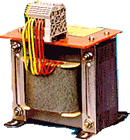 Electrical power is made up of current and voltage Electrical power is made up of current and voltage
P = IV
A transformer allows you to change the current and voltage values within that power equation.
Why do we need transformers?
 Most
of the electronic devices that we use need a transformer if they are to
run or be chargedup by being plugged into the mains. Most
of the electronic devices that we use need a transformer if they are to
run or be chargedup by being plugged into the mains.
Microchip circuitry does not
need a big voltage to operate, in fact a big voltage will simply cause
the chip circuitry to burn out.
Such circuits run on voltages of between
5V and 12V. Therefore a transformer is necessary to 'step-down' mains
voltage (230V) to this level.
Any electronic device you have that can run off batteries
or via a mains connector will have a transformer incorporated into that
connector.
Sometimes they 'hum' and they always get warm after being switched
on for a while.
Transformer Construction
A transformer is a laminated, soft iron core with two insulated
coils of wire wrapped around it.
Q1. Why must is be made of a soft magnetic material?
 (Click here for the answer). (Click here for the answer).
Q2. Laminated means 'made up in layers' - see the photo below. Why must the core be laminated?
 (Click here to see the answer). (Click here to see the answer).
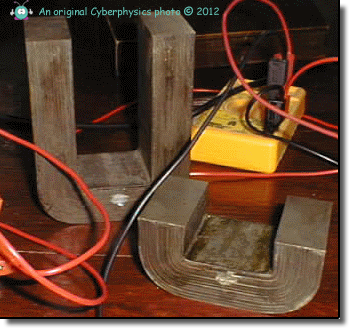
Click here
for Faraday's early experiment
The windings of
the coils are made of low resistance copper.
 Q3. Why do the windings have to be of low resistance? Q3. Why do the windings have to be of low resistance?
 (Click here for the answer) (Click here for the answer)
|
Naming of the coils and drawing a diagram
The first coil is called
the primary coil. This is the coil that has the supply voltage
applied across its ends.
The second coil is called the secondary
coil. This is the coil that has the output voltage across its ends.
This is the coil that is connected to your appliance.
The diagram should be simple - do not draw too many windings - the diagram is only representative of the real thing. Make sure you label it.

How a transformer
works
An alternating
voltage (VP) is applied across the primary coil. This
causes a changing magnetic field to be formed around the primary
coil.
The magnetic domains inside the soft iron core line up in response
to the magnetic field from the coil.
The secondary coil experiences the changing magnetic field produced
by the primary and the core.
It responds to this changing magnetic
field by producing a voltage (VS) across its ends (an
induced EMF) by electromagnetic induction.
(The key words you
must mention when explaining this are in bold type)
Why must the source voltage be an alternating voltage?
Electromagnetic
induction only happens when a wire loop experiences a changing magnetic
field . The wire and field lines must move with respect to each other
so that the wire can 'cut the lines of flux'.
How can we get a
different voltage out of a transformer from the one we put in?
This is achieved
by varying the ratio of the number of turns of wire on the primary and
secondary coils. If there are more turns on the secondary then the output
voltage will be bigger by the same ratio and vice versa.
A step-up transformer
has more turns on the secondary than on the primary. It therefore
produces a bigger output voltage than input voltage.

A step-down transformer
has less turns on the secondary than on the primary. It therefore produces
a smaller output voltage than input voltage.
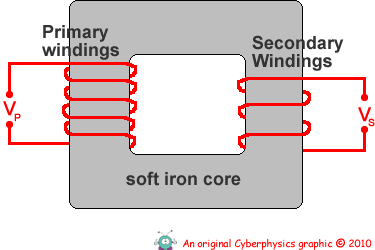
Although transformers
lose some of the energy input as heat (that is why the transformer gets
warm), they are pretty efficient and about 99.9% of the input electrical
energy is converted to output electrical energy. Therefore in examination
questions at this level you can assume that the transformer is 100%
efficient.
In reality they are not 100% efficient and when we are dealing with large energy transfers (GW or TW in the case of power stations) even a small percentage is a large energy loss.
Q4. How can the design of a transformer cut energy losses? (Click here for the answer)
This means that:
power
in = power out
power
of primary = power of secondary
PP
= PS
IPVP
= ISVS
As the voltage is
stepped up, so the current is stepped down!
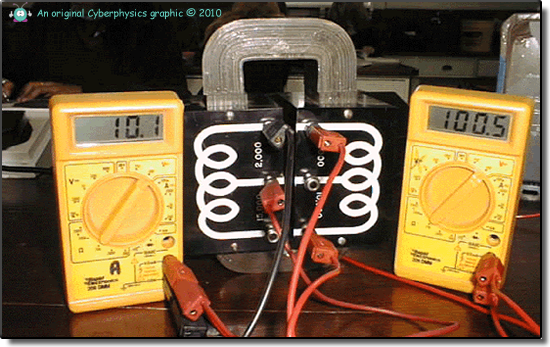
In the above photograph the school transformer was used to demonstrate how voltage can be 'stepped-up' by a transformer..
10.05 V (rounded by the meter to 10.1 V) across the primary coil of 2,000
turns resulted in an output of 100.5 V across the secondary coil of 20,000
turns.
The
Symbol
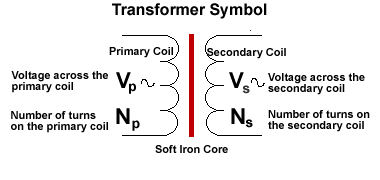
The symbol consists of two curled lines, representing
the coils.
These are unconnected, as there is no connection between
the coils on a real transformer.
The line (sometimes two or three are
drawn) in the middle represent the magnetic link between the coils that
is made by the soft iron core.
The Equation
There is a mathematical link between the number of turns
and the voltages on each coil.

This ratio equation must be known for examination purposes.
It doesn't matter which way up you write it, or which way round. Therefore
always start with the unknown quantity in the top left position.
Click here to see some example questions
|




 The
Transformer
The
Transformer


 Electrical power is made up of current and voltage
Electrical power is made up of current and voltage Most
of the electronic devices that we use need a transformer if they are to
run or be chargedup by being plugged into the mains.
Most
of the electronic devices that we use need a transformer if they are to
run or be chargedup by being plugged into the mains. 
 Q3. Why do the windings have to be of low resistance?
Q3. Why do the windings have to be of low resistance?






